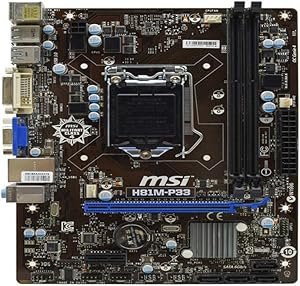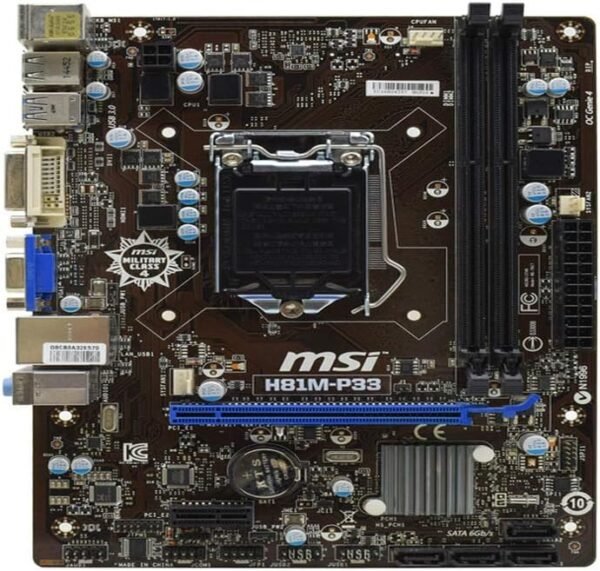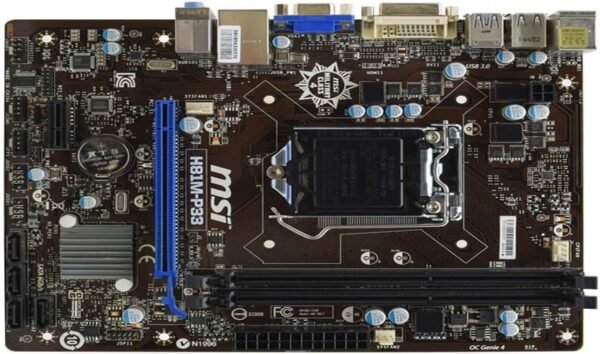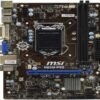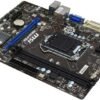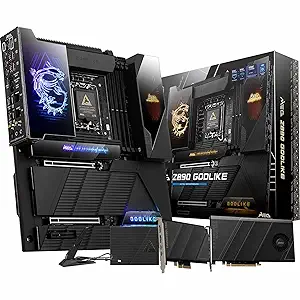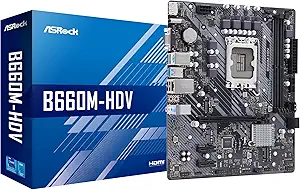MSI H81M-P33 Motherboard review is it the best budget option?
MSI H81M-P33 Motherboard review is it the best budget option?
- Solid build quality ensures durability and long-term reliability.
- Efficient performance compatibility with Core i7 processors offers seamless multitasking.
- The compact microATX design fits perfectly into smaller cases without compromising functionality.
- Dual DIMM slots allow for easy memory upgrades, supporting up to 16GB of DDR3 RAM.
- Multiple USB ports, including USB 3.0, deliver faster data transfer speeds and versatile connectivity.
As an Amazon Associate I earn from qualifying purchases.
Description
A Compact Powerhouse: The MSI H81M-P33 Motherboard
Testing out the MSI H81M-P33 Motherboard has been an interesting experience for someone like me who enjoys building and tinkering with PCs. This microATX motherboard has a lot to offer, particularly for mid-tier users, but there are also some areas where it falls short. While the Intel H81 Express chipset is a bit dated, this motherboard still manages to pack a punch, especially when paired with a compatible Intel Core i7 processor. Let me walk you through my hands-on experience with this board, from its key features to its limitations.
Design and Build Quality
The first thing that struck me about this product was its compact microATX form factor, which makes it an excellent choice for small builds. It feels sturdy despite its lightweight frame (weighing only 2 pounds), and the layout of the DIMM slots, PCI-Ex16 slot, and SATA ports is well thought out. I didn’t struggle with cable management during my build, thanks to the clearly labeled headers and logical placement of components.
However, the design might not appeal to everyone. The board lacks any striking visual flair—there’s no RGB lighting or premium finishes, which might disappoint gamers looking for aesthetics. But if you prioritize functionality over looks, this might not be a dealbreaker.
Performance and Compatibility
Running an Intel Core i7 on this board proved to be a smooth experience. The 100MHz FSB/Hyper Transport Bus handled tasks without hiccups, and the DDR3 memory support—while not cutting-edge—still gets the job done for most everyday applications. I tested it with 16GB of RAM at 1600MHz, and it performed admirably during gaming and multitasking sessions.
That said, the DDR3 memory limitation could be a drawback for those looking to future-proof their systems. Modern motherboards now support DDR4 or DDR5, giving them a performance edge. Additionally, the PCI-E Gen2 slot may bottleneck high-end GPUs, making this board less ideal for power users or those working with resource-intensive software.
Key Benefits
This motherboard does come with several standout advantages that make it a strong contender in its price range:
- Dual DIMM slots supporting up to 16GB of RAM provide adequate memory for most users.
- The inclusion of 2 USB 3.0 ports (rear) and 4 USB 2.0 ports (front) ensures plenty of connectivity options for peripherals.
- Two SATA III ports allow for faster data transfer rates when using SSDs, enhancing system responsiveness.
- The Gigabit LAN port delivers reliable and fast network performance, which I appreciated during online gaming and large file transfers.
Areas for Improvement
Despite its merits, there are a few notable downsides that potential buyers should be aware of:
- The absence of newer technologies like M.2 slots limits storage upgrade possibilities.
- Only one PCI-Ex16 slot restricts your ability to install multiple GPUs or other PCIe devices.
- No onboard Wi-Fi support, which means you’ll need an external adapter or PCIe card to connect wirelessly.
- Lack of advanced overclocking features, making it less appealing for enthusiasts.
While these issues didn’t heavily impact my use case, they could be significant for users with more demanding requirements.
Other Options
When comparing this board to competitors like the ASUS H81M-A and the Gigabyte GA-H81M-DS2, it becomes clear that the MSI H81M-P33 holds its own but isn’t without tough competition. The ASUS H81M-A offers similar specs but includes a more intuitive BIOS interface, making it slightly easier for beginners. On the other hand, the Gigabyte GA-H81M-DS2 boasts better audio quality and an extra SATA III port.
Where the MSI H81M-P33 shines is in its price-to-performance ratio. It delivers reliable performance for everyday tasks and gaming, though it doesn’t quite match the versatility and feature set of its peers.
Financial Value
For those on a budget, this motherboard offers affordable quality. It’s not trying to compete with high-end boards, but it’s a smart choice for users building a basic or mid-range PC. With its solid network capabilities, USB ports, and SATA III support, you’re getting good value for the price. However, if you’re planning to upgrade your system in the near future, investing in a board with more modern features might be a wiser choice.
Would I recommend this motherboard? That depends on your needs. If you’re looking to build a reliable, no-frills PC, this board gets the job done. But if you’re after cutting-edge features or plan to upgrade frequently, you might want to explore other options.
Additional information
| Package Dimensions | 11 x 10 x 2 inches |
|---|---|
| Item Weight | 2 pounds |
| Manufacturer | MSI (Micro Star) |
| Item model number | H81M-P33 |
